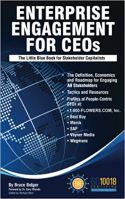Q&A: Professor Stefanie Becker Says Human Capital and Engagement Are Worldwide Issues
ESM recently
reported on the creation of an International Standards Organization committee initiated in Germany to focus specifically on the development of Human Capital metrics and standards. This development is of enormous significance to the field of Enterprise Engagement because these standards and metrics likely will include multiple aspects related to employee engagement. For the perspective from Germany, ESM recently interviewed Dr. Stefanie Becker, who is a member of the German mirror committee of ISO TC 260 and since November 2015 organizer of the Working Group, “Human Capital Reporting for Internal and External Stakeholders” at ISO TC 260.
 Q: Can you briefly describe your own interest and work in human capital and human capital metrics?
Q: Can you briefly describe your own interest and work in human capital and human capital metrics?
A: Since 2004, I have worked for the department of Business Administration, specifically Organizational Behaviour, Human Resource Management and Information Management at the Saarland University in Germany. My doctoral thesis completed in 2011 focused on ethical issues in Human Capital Management and measurement. In my opinion, it is irresponsible for companies to overlook the importance of human capital. It is one of their most relevant assets. However, human capital is frequently concerned primarily with the costs of human resources, not their value. At best, HR professionals may only be able to make an intuitive assessment of the positive effects of human capital on the organization.
That was one reason why our institute developed a formula (known as the Saarbrücken Formula) for determining the value of human capital in Euros (or Dollars). The variables of the ‘Saarbrücken Formula’ focus on how human capital is constituted and how it can be influenced to ensure a stable structure or a structural improvement. The formula combines ‘hard’ data (number of employees, training and development costs) and ‘soft’ data (motivation, etc.) and other human resources data such as knowledge erosion, a measure of the relevance of employee knowledge related to their jobs. I have worked with many companies using this formula for evaluating and optimizing their human capital. Our understanding about the composition of human capital as value or asset (rather than simply a cost) affects our understanding of human capital management. The different elements of the Saarbrücken formula can be used as key control parameters for the management of human resources. They can also be used as metrics for reporting.
Q: What do you believe are the gaps of knowledge in the relationship between human capital and business performance and assessment, and do you believe that most organizations understand this connection?
A: There exists a common understanding that there’s a connection between human capital and corporate performance. However, in academic research only a few studies exist that deal with this issue. The difficulty lies: a) in the different measurement models and understandings about human capital (there is no accepted standard and every study interprets human capital in a different way); and, b) the lack of longitudinal analysis, because the influences from investments in human capital on corporate performance have a delayed effect. If we look into practice, I think organizations understand the connection, but it is more intuitive than knowledge. They don’t know how to measure the connection to make it transparent. However, today it is crucial to represent a full picture of the performance and wealth of an organization, including the ‘human resources’ for internal and external stakeholders.
Q: Can you describe your involvement in the ISO 260 effort and how it came about? What are your key goals?
A: I was invited by my German colleagues from the German mirror committee at German Standardization Institute (DIN), who knew of our work about human capital reporting in Germany and who encouraged me to submit a new work item proposal to ISO TC 260, which we titled “Human Capital Reporting for Internal and External Stakeholders.” In our opinion, a standardized measurement of human capital is not realistic. Investors, for instance, have their own measurement systems and formulas for evaluating human capital as an asset in terms of monetary value. What we should do is to standardize human capital reporting on a global level. Therefore, the objective of the human capital reporting guideline on the ISO level is to establish a common global understanding on human capital reporting for internal and external stakeholders.
Our working group sees the following benefits: First, the use of this guideline describes value in a broadly comparable sense alongside individual case-based solutions. Second, it allows for a greater understanding of the financial and non-financial returns that are generated as a result of investments in human resources and human resource management activities. And finally, external and internal stakeholders can more easily access and derive an understanding of an organization’s human capital and its present and future performance.
Q: What do you believe are the key components of human capital that should be formally managed and tracked by organizations? What would human capital standards and metrics look like – in other words, what would companies disclose?
A: Comparing the areas of the most common approaches to human capital measurement, we find some convergence around the following metrics: labor costs, number of employees, workforce configuration, training and development, motivation, work context, and return on workforce. So there are some key areas, including human capital costs and human capital productivity, with clear key metrics such as total labor costs and human capital return on investment. These metrics can be reported over more than one time period to show changes over time and for different employee groups. Besides the metrics (which can be presented as a fact sheet), the human capital reporting guidelines could also be used as a risk management system regarding human capital assets, identifying key human capital risks and opportunities.
Q: Are you aware of the employee engagement and broader enterprise engagement movements in the U.K. and U.S. based on extensive research showing the connection between engaged employees, engaged customers, and financial performance?
A: Regarding the issue of corporate performance, I think ‘engagement’ and ‘retention’ (or ‘job embeddedness’) are the critical factors for innovation and the ability to constantly adapt to market requirements. For instance, a poor work environment has consequences on the retention, the commitment, the absenteeism rate, and therefore an indirect influence on corporate performance, which always has a negative impact on organizational performance.
Q: Why is it that customers, suppliers and communities are often left out of discussions related to human capital metrics, even though research indicates that the financial benefits from employee engagement come from the impact it has on customers, the quality of suppliers and the support of communities?
A: That is very difficult to answer, because it is tough enough to measure the direct impact of employees’ engagement on financial performance. However, low engagement also has high costs in terms of recruitment, productivity, quality and so on. Besides using an employee commitment index as one potential human capital metric, companies could also report on their customers or suppliers’ satisfaction index. If these metrics were reported, researchers could use them for more longitudinal studies, where also contextual factors (country, company size, industry, etc.) could be considered. Companies that invest more in people and that are public about it are very attractive to potential job candidates, so it is a recruitment opportunity as well to attract the best talent.
Q: The U.K. engagement movement at EngageForSuccess.org believes that the issue of engagement can actually have a positive effect on society, because organizations that believe in people generally pay more and invest more in professional development, etc. From your research, do you see any evidence that there is a greater societal benefit beyond better conditions for employees, customers, and investors?
A: Yes, I think so. That is the more economical perspective of the human capital concept. Investments in people on the company level also have an indirect effect on the society level – better established people, more developed people, more buying power, more innovation and better performance.
 Q: Can you briefly describe your own interest and work in human capital and human capital metrics?
Q: Can you briefly describe your own interest and work in human capital and human capital metrics?  ESM News Alert for the latest news. Subscribe here.
ESM News Alert for the latest news. Subscribe here.
